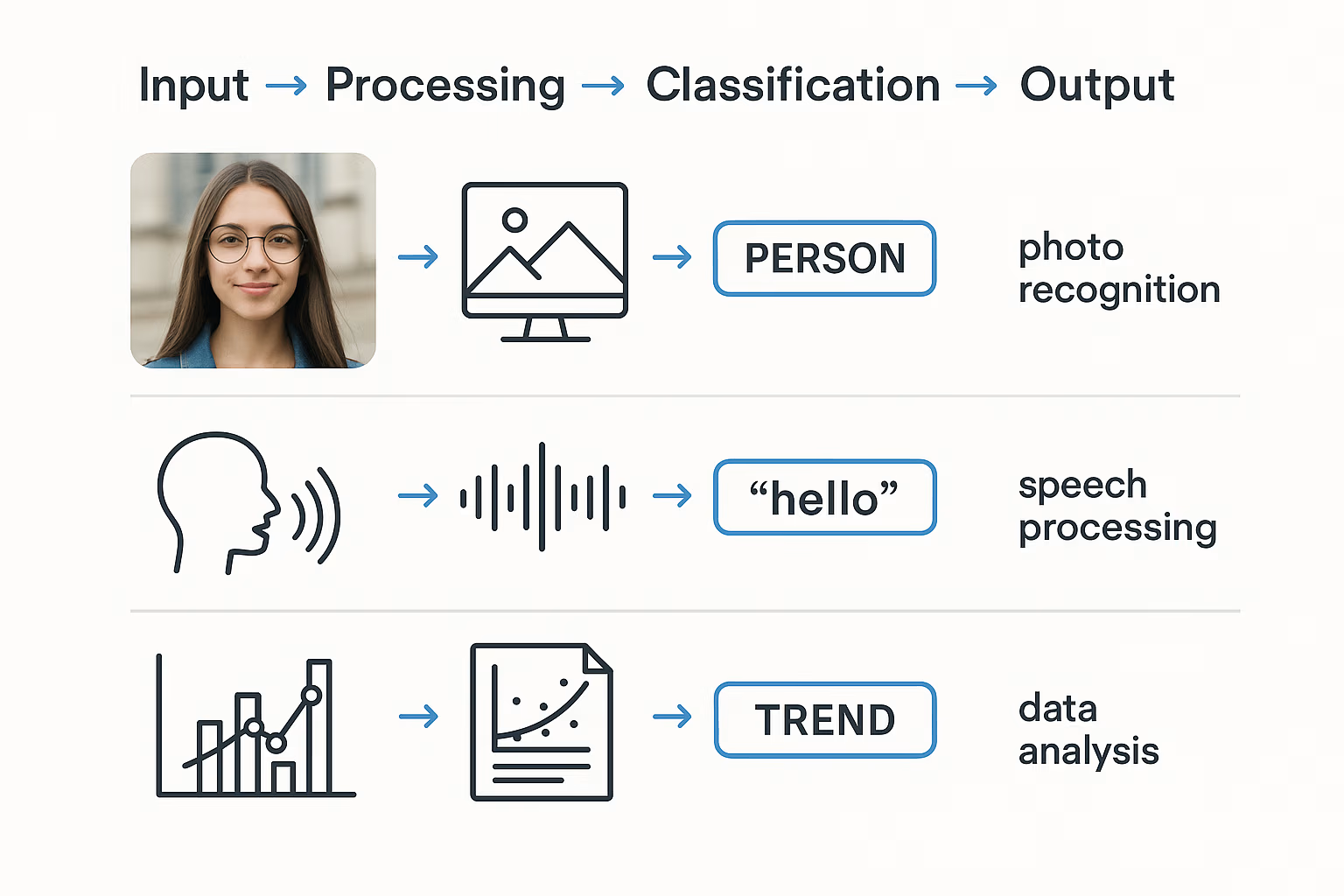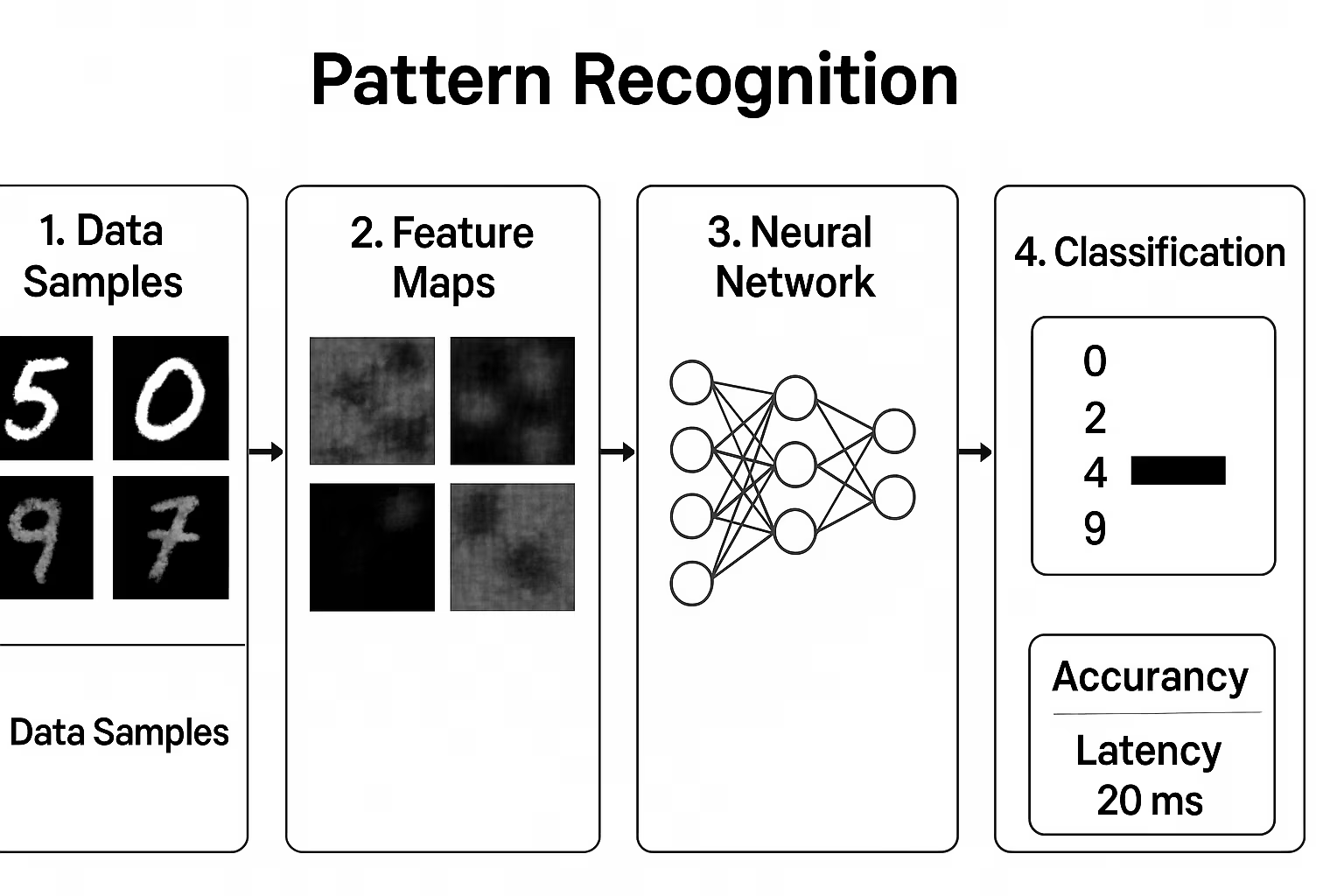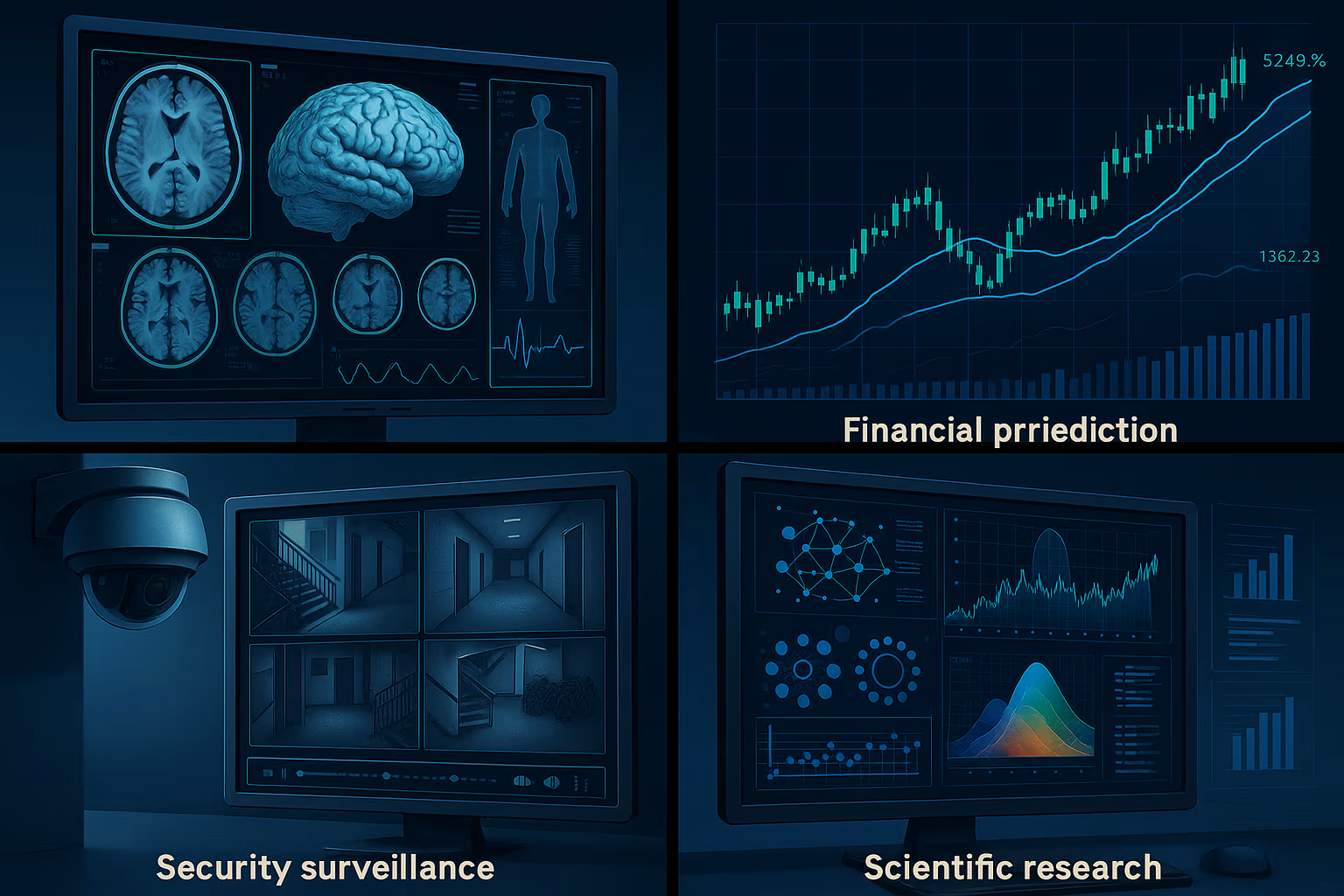Home > Edu-Tech > Pattern Recognition and AI Detection: From Basic Concepts to Advanced Applications.
Pattern Recognition and AI Detection: From Basic Concepts to Advanced Applications.
Pattern recognition is the use of computational analysis and classification algorithms to automatically find patterns, structures, and important information in data.
By :Thomas Inyang🕒 28 May 2025

Introduction
When you wake up in the morning, your smartphone can recognize your face and unlock it. Or consider how spam is filtered out of email apps. Or the way your music app selects songs that are exactly what you like. The technology behind all of these is pattern recognition. You will have a different perspective on how machines learn to see, hear, and think after reading this article.
What you'll discover in this guide:
- What are the principles of pattern recognition that power everything from facial recognition to fraud detection?
- Real-world applications of pattern recognition that are already transforming industries.
- Practical steps to implement pattern recognition in your projects
- What are the advanced techniques for detecting AI-generated content?
- Future trends that will reshape how we interact with technology.
What is Pattern Recognition in Artificial Intelligence?
It is the use of computational analysis and classification algorithms to automatically find patterns, structures, and important information in data.
Think of pattern recognition as teaching a computer to observe things the way humans naturally do. When you see a cloudy sky and predict rain or recognize a friend's laugh in a crowded room, you're using pattern recognition. The difference is that AI systems can process millions of these patterns simultaneously without trembling.
At its core, pattern recognition follows a simple, powerful framework: Input → Processing → Classification → Output. Raw data enters the system, gets analyzed for meaningful features, is compared against learned patterns, and produces a classification or prediction. This process occurs when a medical AI uses X-rays to diagnose diseases or when your phone uses your voice or fingerprint to unlock it.
See Also: DDA Algorithm: How To Draw a Smooth Line Using Python PL Packages—Numpy and Matplotlib
The beauty of modern pattern recognition lies in its versatility. Unlike traditional programming, where you explicitly tell a computer what to do, pattern recognition systems learn from examples. Show an AI system thousands of cat photos labeled "cat," and it begins to understand what makes a cat... well, a cat. The whiskers, pointed ears, and specific body proportions become part of its learned pattern.
What makes a pattern? Patterns exist everywhere around us:
- Visual patterns: The way shadows fall on objects, color gradients in sunset photos, geometric shapes in architecture
- Audio patterns: the rhythm in your favorite song, the beats of different languages, the frequency signatures of musical instruments.
- Data patterns: shopping behaviors during holidays, stock market fluctuations during economic events, and website traffic patterns throughout the day.
- Behavioral patterns: How users navigate through mobile apps, the sequence of actions before making a purchase, communication patterns in social networks

Pattern Recognition in Your Everyday Life
This refers to the seamless integration of automated pattern detection systems in gadgets users use and interact with often to enhance their experience, security protection, and personalize their digital world.
Your Personal Technology Ecosystem
A smartphone is one of the examples of pattern recognition by examining more than 30,000 invisible dots that are projected onto your face when you unlock it using Face ID. As you do this, it keeps learning and adjusting to minute changes in your appearance, such as when you grow facial hair, wear new glasses, or even when the lighting changes.
Email spam filtering is another example. Your inbox stays clean because algorithms analyze patterns in sender behavior, email content, link structures, and even the timing of messages. Every day, these systems process billions of emails, continuously identifying new spam patterns while guaranteeing that you consistently receive legitimate messages.
Entertainment and Media
The recommendation engines powering Netflix, Spotify, and YouTube represent some of the most sophisticated pattern recognition systems in consumer technology. These platforms don't just look at what you've watched or listened to; they analyze when you pause, rewind, skip, or binge-watch content. They identify patterns in viewing habits across millions of users with similar preferences, creating a collaborative filtering system that seems almost telepathic in its accuracy.
See Also: Build and Deploy a RESTful API with MongoDB and Render.
Professional and Industrial Applications
In healthcare, pattern recognition is revolutionizing diagnostic medicine. Radiologists now work alongside AI systems that can identify subtle patterns in medical images by spotting early-stage cancers, predicting heart disease risk, or detecting neurological conditions from brain scans. These systems don't replace human expertise but amplify it, catching patterns that might be difficult to analyze by the human eye while processing images at superhuman speed.
Financial institutions rely heavily on pattern recognition for fraud detection. Every time you swipe your credit card, algorithms instantly analyze the transaction against your historical spending patterns, location data, merchant categories, and global fraud trends. Unusual patterns, such as a purchase in a foreign country minutes after a local transaction, will trigger immediate security responses.
The seamless integration of pattern recognition into daily life shows how far technology has evolved from what was mostly seen in the laboratory to essential infrastructure.

The Science Behind AI Pattern Recognition: How Machines Learn to See.
Artificial intelligence systems use machine learning algorithms that mimic human cognitive processing to recognize, categorize, and interpret patterns in data. Similar to how a child learns to differentiate between various animals by seeing numerous examples: Pattern recognition systems develop their understanding through experience.
The Five Essential Steps of Pattern Recognition
Every effective pattern recognition system follows a structured approach that transforms raw data into meaningful insights:
Step 1: Data Collection and Preparation This step involves gathering high-quality, representative data from relevant sources, which determines the ceiling of your system's performance. Professional systems often spend 60-70% of their development time on data preparation, data cleaning, handling missing values, and ensuring balanced representation across different pattern categories.
Step 2: Feature Extraction and Selection Raw data rarely contain patterns in an immediately usable form. This stage transforms raw information into meaningful characteristics that algorithms can process effectively. In image recognition, this could entail identifying color distributions, edges, and textures. For text analysis, it could include word frequency, sentence structure, and semantic relationships.
See Also: The Concept and Roles of DBMS in Software Development
Step 3: Pattern Learning and Training During this crucial phase, algorithms analyze thousands or millions of examples to identify recurring structures and relationships that human experts had not specifically programmed.
Step 4: Pattern Classification Once trained, the system can classify new, unseen data by comparing it against learned patterns, which involves calculating similarity scores, applying decision boundaries, and managing uncertainty when patterns don't match existing categories perfectly.
Step 5: Validation and Deployment Thorough testing is necessary before the system is deployed in the real world to make sure it operates dependably under different circumstances. A continuous learning mechanism is implemented to monitor for performance failures and adapt to evolving patterns.
Popular Algorithms Powering Pattern Recognition
Different types of patterns require different algorithmic approaches. Convolutional Neural Networks (CNNs) excel at visual pattern recognition, automatically learning to detect features like edges, textures, and complex objects through layers of processing. Recurrent Neural Networks (RNNs) specialize in sequential patterns, making them ideal for speech recognition, language translation, and time-series analysis.
Traditional methods like Support Vector Machines and Random Forest algorithms remain valuable for many applications, especially when dealing with smaller datasets or when interpretability is crucial. The key is matching the right algorithm to your specific pattern recognition challenge.

Training AI to Recognize Patterns: A Practical Approach.
To do this, the machine must be trained to recognize models by categorizing patterns from exposed labeled examples. Additionally, they use iterative learning algorithms to optimize their internal parameters.
See Also: Navigating Through Backend Development: Required Tools, Skills, and Opportunities.
The Art and Science of Dataset Preparation
In pattern recognition training, quality is more important than quantity. A small, carefully chosen dataset frequently performs better than a large number of subpar examples. Professionals concentrate on making sure their training data includes edge cases and difficult situations that could cause the system to malfunction, as well as the entire range of patterns they anticipate seeing in production.
Supervised vs. Unsupervised Learning Strategies
Consider supervised learning as learning with a teacher who gives you the right answers. It is most effective when you have examples that are clearly labeled. This approach powers most commercial pattern recognition systems, from image classification to fraud detection. The algorithm learns by comparing its predictions against known correct answers, gradually improving its accuracy through repeated exposure and correction.
On the other hand, unsupervised learning finds patterns without explicit labels. Examples of this include spotting hidden structures in data about customer behavior or spotting odd network traffic patterns that could point to security risks. When labeled data is costly or impossible to obtain, this method works wonders.
See Also: How to Get Started with Front-End Development for Beginners: A Step-by-Step Guide.
Transfer Learning: Standing on the Shoulders of Giants
Using pre-trained models as starting points rather than starting from scratch is one of the most effective methods in modern AI training. This method frequently produces better results and cuts down training time and data requirements.
Best Methods for Robust Pattern Recognition
No successful trained model uses a single approach. Ensemble methods combine predictions from multiple models; they reduce the weaknesses of individual algorithms while boosting overall accuracy. Hybrid approaches might combine traditional statistical methods with modern deep learning, leveraging the strengths of each approach.
Context-aware is a pattern recognition development that identifies isolated patterns and understands how patterns relate to their environment and circumstances. A security system might recognize that certain behavior patterns are normal during business hours but suspicious at midnight.
The goal isn't just to build a system that works in the laboratory but one that performs reliably in the real world.

What is AI Detection and Recognition
It refers to the technological capability to identify artificially generated content, whether text, images, audio, or video, by analyzing statistical patterns and characteristics that distinguish machine-generated output from human-created content.
The detection of AI-generated content has become a crucial area of concern. Using AI to detect AI is a "meta-challenge" that is one of the most intriguing and practically significant advancements in contemporary pattern recognition.
The AI Detection Tools
There are different tools, each with distinct strengths and limitations. Winston AI has established itself as a leader in accuracy, particularly for detecting content from ChatGPT, GPT-4, and Google Gemini, with 99% accuracy for many content types. Originality.ai uses ensemble methods by combining multiple models, including modified BERT and RoBERTa architectures, to analyze text patterns.
Copyleaks has proven to handle over 30 languages while maintaining high accuracy across diverse content types. Grammarly's AI detector takes a user-friendly approach, providing percentage confidence scores that help users understand the likelihood of AI generation rather than binary yes/no answers.
How AI Detects AI: Technical Mechanisms
The technique relies on identifying clever styles that distinguish human- and machine-generated content. Human writing is known for syntax and semantics inconsistencies, emotional variations, and unpredictable stylistic choices that current AI systems struggle to perfectly replicate. Detection algorithms examine things like logical flow structures, coherence patterns, vocabulary diversity, and sentence complexity distribution.
Behavioral Pattern Analysis looks at how content changes over time. Humans tend to write with more variation (tone and semantics), make different kinds of mistakes, and have unique linguistic patterns that AI systems still can’t replicate fully.
Practical Applications and Professional Use Cases
While content creators use AI detection tools to confirm the authenticity of their work, educational institutions are increasingly depending on these systems to uphold academic integrity. In order to maintain editorial standards and guarantee content originality, publishers and media organizations incorporate AI detection into their workflow.
As the complexity of generation systems increases, detection techniques need to change and advance. Users must keep up with the most recent advancements with these techniques.
Advanced Applications: Where Pattern Recognition Meets Real-World Impact
The following areas show the true potential of AI pattern recognition beyond consumer convenience:
Law Enforcement and Security Applications
Facial recognition systems now process millions of images from various sources, helping identify suspects, locate missing persons, and enhance public safety. These systems analyze facial geometry, distinctive features, and even behavioral patterns captured in video footage.
See Also: Input Validation and its Role In Preventing Cyber Attacks
Digital forensics These systems can identify hidden patterns in communication, detect evidence tampering, and reconstruct digital timelines that prove crucial in legal proceedings.
Behavioral pattern analysis helps threat assessment teams identify potentially dangerous individuals before they act by analyzing communication patterns, online behavior, and movement patterns.
Predictive Analytics and Forecasting
In order to enable precise forecasting across various domains, this analytics is used to find trends and patterns. These systems are used by financial institutions for algorithmic trading, which analyzes economic indicators, news sentiment, and market patterns to make snap investment decisions.
By using pattern recognition on satellite imagery, atmospheric data, and past weather patterns, weather forecasting has been transformed. These systems can predict severe weather events that can potentially save lives and property.
Pattern recognition is a tool used in supply chain optimization to forecast changes in demand, spot possible changes, and improve inventory control. These systems examine economic indicators, seasonal trends, consumer behavior patterns, and even sentiment on social media.
Healthcare and Medical Applications
Diagnostic imaging systems now assist radiologists in detecting early-stage cancers, neurological conditions, and cardiovascular diseases by identifying subtle patterns in medical images that might escape human observation.
Drug discovery These systems can identify promising drug candidates and predict potential side effects by recognizing patterns in how different compounds interact with biological systems.
Personalized medicine uses pattern recognition to analyze individual patient data, genetic profiles, and treatment responses to recommend optimal therapeutic approaches tailored to each patient's unique characteristics.

Career Opportunities and Professional Development
Pattern recognition data scientists earn good money, and companies in all industries are increasingly looking for AI engineers with pattern recognition skills.
Businesses that understand the need for pattern recognition use it to obtain major competitive advantages in different business areas, including supply chain optimization and customer behavior analysis.
As we conclude this article, remember that pattern recognition is changing rapidly. The patterns we recognize today will expand tomorrow, and the applications we consider advanced now will become commonplace.
Conclusion
From the apps on your phone to the complex systems safeguarding our security and advancing medical science, pattern recognition is one of the most revolutionary technologies of our time. As our world continues to be shaped by these systems, it becomes more and more important to comprehend how they function, their potential, and their limitations.
In order to help businesses that wish to incorporate pattern recognition into their business model, the principles discussed in this article focused on the fundamentals, practical applications, and future research. In addition, this article will be helpful to others who wish to pursue careers in technology and artificial intelligence.
The only things limiting pattern recognition's promising future are our creativity and our dedication to creating these potent technologies in an ethical and responsible manner. As you proceed, keep in mind that the most effective pattern recognition applications blend advanced technical skills with a profound comprehension of human needs and values.
Please Share